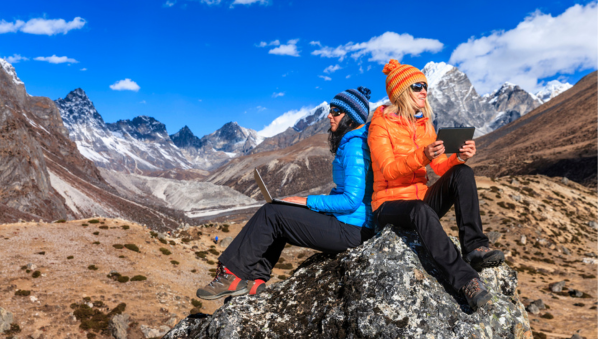Preparing for an outdoor excursion can be key to a safe and successful experience. Knowing what to do when you get lost or run into trouble can be the difference between life and death. Before you go, make sure you are properly prepared if you happen to lose cell signal along the way.
Make sure someone knows where you are
When going on a hike or exploring in a park, it's critical to let someone know where you are and when you plan to return. This can help if you get lost, as someone will know where to look for you if you don’t come home at the predetermined time. You can either talk to your family or friends or contact park rangers to inform them of your plan. Make sure to share your detailed route with your contacts so they can easily track your location — even without cell service.
Use maps and a compass
Printing out maps of hiking trails, parks, and general area topography can help hikers and campers avoid getting lost, especially without access to a phone. Learning how to use a compass can also help you keep your bearings. Compasses use the Earth's magnetic field to orient themselves in the cardinal directions — north, south, east, and west. By understanding how to use a compass, you can always know which way is home, even if you're lost in the wilderness without internet access.
Research cell reception
When camping or hiking, it is important to understand the area's potential Wi-Fi availability and cell service in national parks. Although both are not always guaranteed, doing pre-trip research can be helpful. For example, checking the campground website or contacting the park directly can give you a good idea of what to expect.
However, before connecting to any public Wi-Fi network while on vacation, it is crucial to know the risks. These networks can be vulnerable to hackers looking to steal personal information or passwords. This is why it is always best to use a VPN (Virtual Private Network) while on public Wi-Fi. A VPN encrypts all internet traffic and can help protect your data from being compromised. You will be safer using public Wi-Fi in lieu of cellular data when you have a VPN installed.
Also, ensure that your service provider will help protect your privacy by providing a secure connection and keeping your account safe from fraud so you can focus on enjoying your time away from home. Understanding the most important wireless issues and how to avoid them by taking precautions can help you have a safe and relaxing trip.
It is also important to protect your physical devices in a public area. Keeping your devices in a secure place, like a backpack or carrying case, can help reduce the risk of them being stolen. If they’re stolen, you’ll most definitely be without cell service. All of these data security tips are important to consider as you prepare to take your phone camping or hiking. Many people use their cell phones for emergencies, so preparing your mobile data security beforehand is crucial when time may be tight and considerations like this fall by the wayside.
Pack appropriately
When camping or hiking, it is always crucial to pack well. This is especially true when venturing into the wilderness with the possibility of losing cell signal or becoming lost. Make sure to pack the appropriate supplies. These include items like food, clothing, and tools.
Food is one of the most important items to pack. You must ensure that you have enough food to last for the duration of your trip. In addition, you should pack items that are calorie-rich and easy to digest. Trail mix, granola bars, and dried fruit are all excellent options.
Another critical item to pack is clothing. You need to have clothes that will keep you warm and dry in all types of weather. In case you get wet or dirty, it's a good idea to bring extra clothes with you.
Finally, it is essential to pack the proper tools. This includes a knife, flashlight, lighter, and solar-powered cell phone charger, so you can keep your phone powered in case of any emergencies. These items can come in handy in a variety of situations. However, it would be best if you refrained from overpacking so you are not carrying too much weight.
Learn simple navigation techniques
Knowing simple navigation techniques can help prevent dangerous situations from occurring. For example, there are alternative navigation methods, like the shadow tip method, the watch method, and the observation of tree growth patterns. These can help you reach your destination safely without access to a GPS.
The shadow tip method is a way of using shadows to determine your location. To use this strategy, mark the tip of the shadow with a stone or twig. This mark represents the west. The shadow's tip will move slightly after about 10 to 15 minutes. At this point, also mark the shadow's tip. Then draw a straight line through the two marks. You are positioned to face north by standing with the first mark to your left and the second mark to your right.
The watch method is another way of determining your location using the sun. To use this method, lay a watch evenly and adjust its hour hand with the course of the sun. The center point between the arrangement of the sun with the hour hand and the 12 o'clock position on the dial roughly shows you which direction is south.
Tree growth patterns are another way to determine your location. Trees can be used to find north and south by looking at their growth patterns. Trees growing more on one side than another indicate a specific direction. For example, their branches can grow where they can get the most sun. This means that there will be more branches on the south-facing side of a tree.









